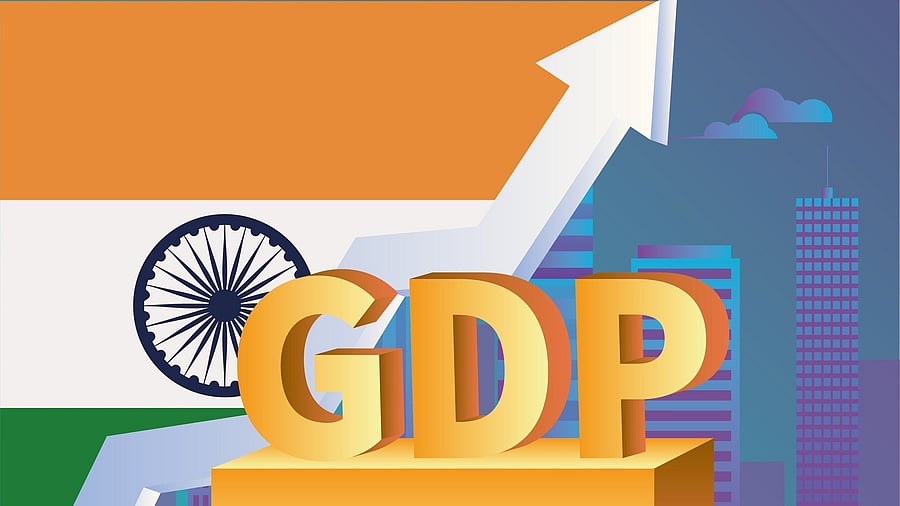
Illustration showing growth in India's GDP.
Credit: iStock Photo
India's economic trajectory is a story of growth and resilience — global headwinds notwithstanding. The National Statistics Office released the Second Advance Estimates for the Annual Gross Domestic Product (GDP) for 2024-2025 on February 28, providing insights into the nation's economic performance and the feasibility of reaching the $5-trillion GDP milestone.
As per the statistics released, for FY2025, India's nominal GDP is projected at ₹331.03 lakh-crore, reflecting a 9.9% growth over the previous year. In real terms, adjusted for inflation, the GDP is estimated to grow by 6.5%, which is in line with the International Monetary Fund (IMF)’s expectations. This figure is milder compared to the impressive growth of 9.2% achieved in FY2024, but still sustains India as the fastest growing major economy in the world. This indicates robust economic activity given the global geopolitical uncertainties.
The current nominal GDP roughly translates to $3.8 trillion at an exchange rate of ₹87 per USD. This is below the long-cherished target of $5 trillion. Initially, the government aimed to achieve this milestone by 2024-2025. However, unforeseen challenges, including the Covid-19 pandemic and global economic slowdowns, had necessitated a revision of this target. If the current nominal GDP growth rate of 9.9% is sustained, India can reach the projected $5 trillion mark by FY2028, assuming the rupee doesn’t weaken further against the US dollar, and a stable exchange rate is maintained. This underscores the need for enhanced economic reforms, increased investments, and sustained growth across all sectors.
When it comes to sectoral contribution, India’s economy continues to be dominated by the tertiary sector. The tertiary sector, which includes trade, hotels, transport, communication, financial services, real estate, and professional services, contributes over half of the nominal gross value added (GVA) at 55%, while the secondary sector encompassing manufacturing, electricity, gas, construction accounts for 25.2%. The primary sector, comprising agriculture, livestock, forestry and fishing, mining and quarrying, though critical for employment, has a relatively smaller share in economic output at about 19.8%.
Measured using real GVA (at 2011-2012 prices), the primary sector is expected to grow by 4.4% in 2024-2025, the secondary sector at 5.8%, and the tertiary sector at 7.3%.
The manufacturing sector shows an estimated growth of 4.3%, a worrying deceleration from the previous year’s 12.3%. This shows much focus is needed for the secondary sector to catalyse economic growth while supporting agriculture with appropriate policy measures to ensure the welfare and well-being of the rural population and to prevent food security slipping out of the radar.
While India has reaped the benefit of economic growth, the per capita income of the most populous nation in the world is a different story altogether. India's per capita income at current prices (based on net national income) for 2024-2025 is estimated at ₹2,05,579 and per capita GDP at ₹2,35,108.
In terms of GDP per capita at current prices in dollar terms, the IMF estimates India's GDP per capita for 2024 at $2,700 and for 2025 at $2,940. This is significantly low even compared among the emerging market and developing economies. For comparison, according to the IMF's World Economic Outlook (October 2024), the estimated global average GDP per capita at current prices for 2025 is $14,450, with advanced economies averaging $61,420 and emerging market and developing economies averaging $6,950.
This statistic of per capita income is just that: a statistic, a mathematical average — the national income divided by the population. While this simple statistic itself paints a grim picture, it does not reflect the middle-most (median) income, which could be still lower, and it does not take into account the skewed income distribution. In a country with significant income inequality like India, this matters. As per a working paper of the World Inequality Lab published in March 2024, India’s top 1% holds 40.1% of the wealth in 2022-2023, among the very highest in the world.
This shows an urgent need for achieving inclusive growth. While the goal of $5-trillion GDP is lofty and desired, it will require sustained focus on equitable development to ensure that economic gains translate into improved living standards for all citizens.
(Usha Ganapathy Subramanian is a practising company secretary, and Ranjith Krishnan is a sustainability consultant)